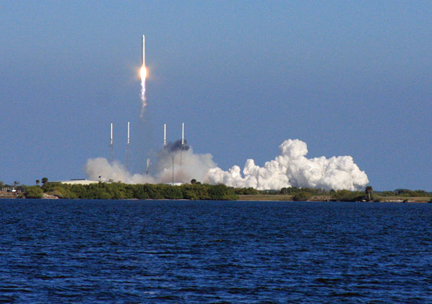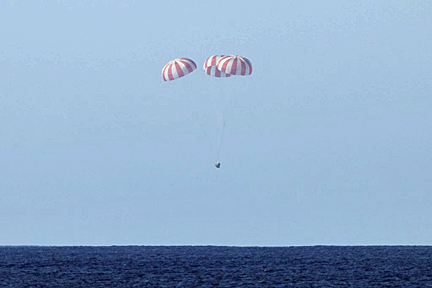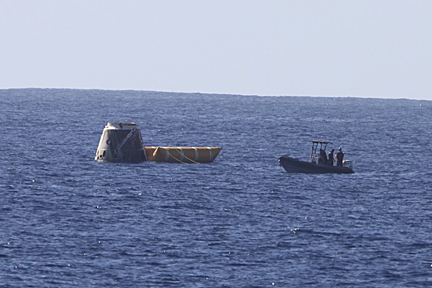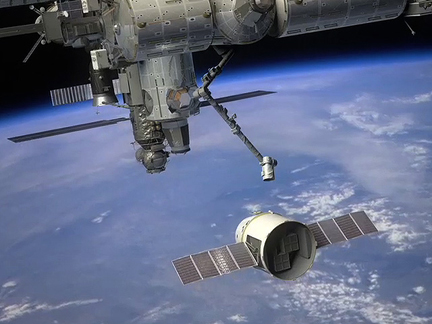SpaceX hails 'mind-blowingly awesome' test flight
Editor's note...
CBS News
KENNEDY SPACE CENTER, FL--A commercially developed rocket critical to the long-term health of the International Space Station blasted off Wednesday on a long-awaited test flight, boosting an untried cargo craft into orbit for a successful, "mind-blowingly awesome" maiden flight, the company's founder said.
Operating autonomously, the Dragon carried out a pre-planned set of maneuvers during two orbits to mimic critical phases of a rendezvous with the International Space Station and to exercise its 18 thrusters, its power system and its navigation and control equipment and software.
It then carried out a de-orbit rocket firing, plunged back into the atmosphere and making a pinpoint landing in the Pacific Ocean some 500 miles west of Baja California just after 2 p.m. EST (GMT-5).
Company officials said the capsule achieved all of its planned objectives, becoming the first commercially-built spacecraft to be launched into orbit and safely returned to Earth.
"This has really been better than I expected," said SpaceX founder Elon Musk, the CEO and chief technology officer. "Just looking at all the mission data, both realtime and what's come back from the stored telemetry, it's actually almost too good. I shouldn't seem surprised by that!"
Bretton Alexander, president of the Commercial Spaceflight Federation, said in a statement the mission represented "a milestone on the path to realizing the first commercial human spaceflight capability. It's historic in that it's the beginning of a paradigm shift from a government human spaceflight architecture to one that opens up human spaceflight to the private sector."
The flight was the first of three financed by NASA under a $278 million Commercial Orbital Transportation Services -- COTS -- contract, the centerpiece of a program designed to encourage development of private sector rockets to deliver cargo to the International Space Station after the space shuttle is retired next year.
Based on the results of the first test flight, Musk said he plans to lobby NASA to combine elements of the second and third missions and to send the next Dragon directly to the International Space Station next summer.
NASA Administrator Charles Bolden told CBS News he would rely on NASA engineers and managers in the COTS program to make that assessment, saying "what our folks have to do is sit down, take a look at results from this test and see how do we interpret what we see and how do we transfer that into comfort that a different-configured vehicle" will perform as required.
But Musk said he was confident Dragon will be up to the task. Looking further down the road, he said the Dragon capsule can easily be modified to carry astronauts to and from the space station within two or three years and that with a superior heat shield, it will rival or exceed the capabilities planned for NASA's deep space Orion capsule.
"People sometimes think that to take a cargo spacecraft and put a crew into it requires this enormous amount of magical pixie dust or something," he said. "This is not at all the case. If there had been people sitting in the Dragon capsule today they would have had a very nice ride. They would have experienced maybe up to four-and-a-half Gs, about what you'd see in an amusement park, and they would have done quite well."
With the additional of escape rockets, seats, solar panels and a few other "minor upgrades," Musk said, "the vehicle you saw today can easily transport people." And unlike the current Dragon spacecraft, Musk said a manned version will not splash down in the ocean when it returns to Earth.
"We're actually going to be aiming for a propulsive landing with gear, kind of like (the Apollo 11) Eagle landed on the moon," he said. "We'll still have the parachutes as a backup, but it's going to be a precision landing, you can literally land on something the size of a helipad, refuel and take off again. That will be the next generation Dragon."
But the clear focus of near-term development is perfecting the Dragon cargo capsule and beginning space station deliveries next year, a critical milestone as NASA transitions to the post-shuttle era, relying on a variety of cargo craft to deliver the supplies needed to support a full-time crew of six.
Capable of carrying 13,200 pounds of cargo in pressurized and unpressurized cargo bays, the Dragon spacecraft can deliver more than twice the load of supplies carried by Russian Progress cargo ships.
SpaceX hopes to begin actual cargo delivery flights next November under a 12-flight $1.6 billion Commercial Resupply Services contract with NASA that calls for the delivery of 44,000 pounds of equipment and supplies to the International Space Station. NASA hopes to operate the station through at least 2020 and SpaceX may be asked to provide additional missions, boosting the contract's value up to $3.1 billion.
"What a great day for SpaceX, what a great day for NASA and what a historic day for commercial space flight," said Alan Lindenmoyer, manager of the commercial crew and cargo program at the Johnson Space Center in Houston. "There was a long list of these objectives we had laid out for this flight. We didn't expect to have them all met, but as the day went along we ended up checking off all of the mission objectives for this demonstration flight.
"From all indications, it looks like it was 100 percent successful and it was just a great experience and wonderful to watch. ... We're certainly looking forward to our next demonstration flight and taking the next step closer to space station. Thank you for the early Christmas present. What a great way to start the holidays."
Former NASA Administrator Mike Griffin, who oversaw implementation of the COTS program, said in an email the Falcon 9/Dragon launch was a "stunning achievement for SpaceX."
"New launch systems are notable for their high failure rate on early test flights, yet Falcon 9 is now two-for-two with its success today," he said. "Moreover, the first flight of any new air- or spacecraft is an uncertain event, even more so when the vehicle must be reentered and recovered. To accomplish all of this so early in the planned flight test sequence is a marvelous feat for SpaceX."
Running a day late because of work to cut away a cracked section of the rocket's second-stage engine nozzle, the Falcon 9's nine first stage Merlin engines roared to life at 10:43 a.m. and quickly throttled up to full thrust. After a final round of lightning-quick computer checks, hold down clamps released and the 157-foot-tall rocket majestically climbed away from launch complex 40 at the Cape Canaveral Air Force Station.
The early moments of the flight appeared flawless as the white booster streaked away to the east through a cloudless blue sky trailing a brilliant jet of flame and a billowing cloud of exhaust.
The first stage engines shut down as planned just under three minutes into flight, the stage fell away and the single engine in the second stage ignited for a planned six-minute boost to orbit. Television views from a camera mounted at the base of the second stage showed first stage separation and the ignition of the second stage engine, its nozzle glowing cherry read from the heat of combustion.
The second stage appeared to fire normally, shutting down nine minutes after liftoff. About 35 seconds later, the Dragon cargo craft could be seen in another "rocket cam" video feed separating from the second stage, released into a slightly elliptical 186-mile-high orbit tilted 34 degrees to the equator.
Musk said the spacecraft performed a variety of maneuvers to demonstrate the guidance and propulsion systems' ability to rendezvous with the International Space Station.
"The maneuvers that were conducted were very similar to the sort of maneuvers we would conduct when going to the space station," Musk said. "There's no meaningful difference in complexity."
All of the systems worked normally, he said. Following the deorbit rocket firing, the Dragon capsule reoriented itself heatshield first and plunged back into the atmosphere with a 12-degree angle of attack. Drogue parachutes deployed on time, followed by release of three huge orange-and-white parachutes.
The spacecraft, the first privately built vehicle to win an FAA license for re-entry and landing, made a pinpoint splashdown within sight of recovery forces.
The ability to recover Dragon is a key selling point because it will allow NASA to bring back failed components, trash and, most important, experiment samples that cannot otherwise be returned to Earth with existing Russian, European and Japanese cargo ships.
"It was definitely a moment of elation and great relief," Musk said of the splashdown. "Drogue deploy and main chute deploy were the riskiest points in the mission. So when those main chutes came out, it was a done deal. It's just mind-blowingly awesome."
He said the capsule will be returned to the SpaceX plant in Hawthorne, Calif., and disassembled for a detailed inspection and analysis.
SpaceX had hoped to launch the Falcon 9/COTS-1 mission Tuesday, but the flight was delayed 24 hours to fix a problem with two cracks in the outermost section of a rocket nozzle extension used by the second stage engine.
The cracks were caused by "fluttering" produced by a nitrogen purge venting onto the thin nozzle. The nozzle extension is not needed for the test flight and a company expert was flown in from California to cut the damaged section away. A diffuser on the vent line to prevent additional problems.
The technician who repaired the nozzle "has a huge fear of flying," Musk said. "It took an enormous amount of will to actually just get on a plane. He won't fly for anything. But he got on a plane for this."
An initial launch attempt Wednesday was called off two minutes and 50 seconds before a planned 9:06 a.m. liftoff because of a "false abort" indication in ground system telemetry. The problem was corrected and the countdown was recycled for 10:43 a.m.
SpaceX hoped to retrieve the Falcon 9 first stage and rented a space shuttle booster recovery ship that was standing by off the coast of Cape Canaveral. But Musk said the stage did not survive its fall back to Earth and that it was not recovered. He said telemetry will help company engineers design improvements in future vehicles that should improve the odds of retrieval.
"No one's ever recovered a liquid first stage intact," he said. "It's difficult to do."
- Posted at 05:55 PM, 12/08/10: SpaceX hails 'mind-blowingly awesome' test flight
- Updated at 06:25 PM, 12/08/10: Adding quotes; photograph of parachute descent
- Reposting at 08:00 PM, 12/10/10: Reposting to correct file system error that reset the date/time of the posting.
CBS News
KENNEDY SPACE CENTER, FL--A commercially developed rocket critical to the long-term health of the International Space Station blasted off Wednesday on a long-awaited test flight, boosting an untried cargo craft into orbit for a successful, "mind-blowingly awesome" maiden flight, the company's founder said.
 |
| The Falcon 9 rocket blasts off from launch complex 40 at the Cape Canaveral Air Force Station. (Credit: Spaceflight Now/Justin Ray) |
It then carried out a de-orbit rocket firing, plunged back into the atmosphere and making a pinpoint landing in the Pacific Ocean some 500 miles west of Baja California just after 2 p.m. EST (GMT-5).
Company officials said the capsule achieved all of its planned objectives, becoming the first commercially-built spacecraft to be launched into orbit and safely returned to Earth.
"This has really been better than I expected," said SpaceX founder Elon Musk, the CEO and chief technology officer. "Just looking at all the mission data, both realtime and what's come back from the stored telemetry, it's actually almost too good. I shouldn't seem surprised by that!"
Bretton Alexander, president of the Commercial Spaceflight Federation, said in a statement the mission represented "a milestone on the path to realizing the first commercial human spaceflight capability. It's historic in that it's the beginning of a paradigm shift from a government human spaceflight architecture to one that opens up human spaceflight to the private sector."
 |
| The Dragon spacecraft descending to a Pacific Ocean splashdown. (Credit: SpaceX |
Based on the results of the first test flight, Musk said he plans to lobby NASA to combine elements of the second and third missions and to send the next Dragon directly to the International Space Station next summer.
NASA Administrator Charles Bolden told CBS News he would rely on NASA engineers and managers in the COTS program to make that assessment, saying "what our folks have to do is sit down, take a look at results from this test and see how do we interpret what we see and how do we transfer that into comfort that a different-configured vehicle" will perform as required.
But Musk said he was confident Dragon will be up to the task. Looking further down the road, he said the Dragon capsule can easily be modified to carry astronauts to and from the space station within two or three years and that with a superior heat shield, it will rival or exceed the capabilities planned for NASA's deep space Orion capsule.
"People sometimes think that to take a cargo spacecraft and put a crew into it requires this enormous amount of magical pixie dust or something," he said. "This is not at all the case. If there had been people sitting in the Dragon capsule today they would have had a very nice ride. They would have experienced maybe up to four-and-a-half Gs, about what you'd see in an amusement park, and they would have done quite well."
 |
| After a problem-free descent from orbit, the SpaceX Dragon cargo capsule bobs in the Pacific Ocean after its maiden test flight. (Credit: SpaceX |
"We're actually going to be aiming for a propulsive landing with gear, kind of like (the Apollo 11) Eagle landed on the moon," he said. "We'll still have the parachutes as a backup, but it's going to be a precision landing, you can literally land on something the size of a helipad, refuel and take off again. That will be the next generation Dragon."
But the clear focus of near-term development is perfecting the Dragon cargo capsule and beginning space station deliveries next year, a critical milestone as NASA transitions to the post-shuttle era, relying on a variety of cargo craft to deliver the supplies needed to support a full-time crew of six.
Capable of carrying 13,200 pounds of cargo in pressurized and unpressurized cargo bays, the Dragon spacecraft can deliver more than twice the load of supplies carried by Russian Progress cargo ships.
SpaceX hopes to begin actual cargo delivery flights next November under a 12-flight $1.6 billion Commercial Resupply Services contract with NASA that calls for the delivery of 44,000 pounds of equipment and supplies to the International Space Station. NASA hopes to operate the station through at least 2020 and SpaceX may be asked to provide additional missions, boosting the contract's value up to $3.1 billion.
"What a great day for SpaceX, what a great day for NASA and what a historic day for commercial space flight," said Alan Lindenmoyer, manager of the commercial crew and cargo program at the Johnson Space Center in Houston. "There was a long list of these objectives we had laid out for this flight. We didn't expect to have them all met, but as the day went along we ended up checking off all of the mission objectives for this demonstration flight.
"From all indications, it looks like it was 100 percent successful and it was just a great experience and wonderful to watch. ... We're certainly looking forward to our next demonstration flight and taking the next step closer to space station. Thank you for the early Christmas present. What a great way to start the holidays."
Former NASA Administrator Mike Griffin, who oversaw implementation of the COTS program, said in an email the Falcon 9/Dragon launch was a "stunning achievement for SpaceX."
"New launch systems are notable for their high failure rate on early test flights, yet Falcon 9 is now two-for-two with its success today," he said. "Moreover, the first flight of any new air- or spacecraft is an uncertain event, even more so when the vehicle must be reentered and recovered. To accomplish all of this so early in the planned flight test sequence is a marvelous feat for SpaceX."
 |
| An artist's rendering of a SpaceX Dragon cargo craft approaching the International Space Station. (Credit: SpaceX) |
The early moments of the flight appeared flawless as the white booster streaked away to the east through a cloudless blue sky trailing a brilliant jet of flame and a billowing cloud of exhaust.
The first stage engines shut down as planned just under three minutes into flight, the stage fell away and the single engine in the second stage ignited for a planned six-minute boost to orbit. Television views from a camera mounted at the base of the second stage showed first stage separation and the ignition of the second stage engine, its nozzle glowing cherry read from the heat of combustion.
The second stage appeared to fire normally, shutting down nine minutes after liftoff. About 35 seconds later, the Dragon cargo craft could be seen in another "rocket cam" video feed separating from the second stage, released into a slightly elliptical 186-mile-high orbit tilted 34 degrees to the equator.
Musk said the spacecraft performed a variety of maneuvers to demonstrate the guidance and propulsion systems' ability to rendezvous with the International Space Station.
"The maneuvers that were conducted were very similar to the sort of maneuvers we would conduct when going to the space station," Musk said. "There's no meaningful difference in complexity."
All of the systems worked normally, he said. Following the deorbit rocket firing, the Dragon capsule reoriented itself heatshield first and plunged back into the atmosphere with a 12-degree angle of attack. Drogue parachutes deployed on time, followed by release of three huge orange-and-white parachutes.
The spacecraft, the first privately built vehicle to win an FAA license for re-entry and landing, made a pinpoint splashdown within sight of recovery forces.
The ability to recover Dragon is a key selling point because it will allow NASA to bring back failed components, trash and, most important, experiment samples that cannot otherwise be returned to Earth with existing Russian, European and Japanese cargo ships.
"It was definitely a moment of elation and great relief," Musk said of the splashdown. "Drogue deploy and main chute deploy were the riskiest points in the mission. So when those main chutes came out, it was a done deal. It's just mind-blowingly awesome."
He said the capsule will be returned to the SpaceX plant in Hawthorne, Calif., and disassembled for a detailed inspection and analysis.
SpaceX had hoped to launch the Falcon 9/COTS-1 mission Tuesday, but the flight was delayed 24 hours to fix a problem with two cracks in the outermost section of a rocket nozzle extension used by the second stage engine.
The cracks were caused by "fluttering" produced by a nitrogen purge venting onto the thin nozzle. The nozzle extension is not needed for the test flight and a company expert was flown in from California to cut the damaged section away. A diffuser on the vent line to prevent additional problems.
The technician who repaired the nozzle "has a huge fear of flying," Musk said. "It took an enormous amount of will to actually just get on a plane. He won't fly for anything. But he got on a plane for this."
An initial launch attempt Wednesday was called off two minutes and 50 seconds before a planned 9:06 a.m. liftoff because of a "false abort" indication in ground system telemetry. The problem was corrected and the countdown was recycled for 10:43 a.m.
SpaceX hoped to retrieve the Falcon 9 first stage and rented a space shuttle booster recovery ship that was standing by off the coast of Cape Canaveral. But Musk said the stage did not survive its fall back to Earth and that it was not recovered. He said telemetry will help company engineers design improvements in future vehicles that should improve the odds of retrieval.
"No one's ever recovered a liquid first stage intact," he said. "It's difficult to do."